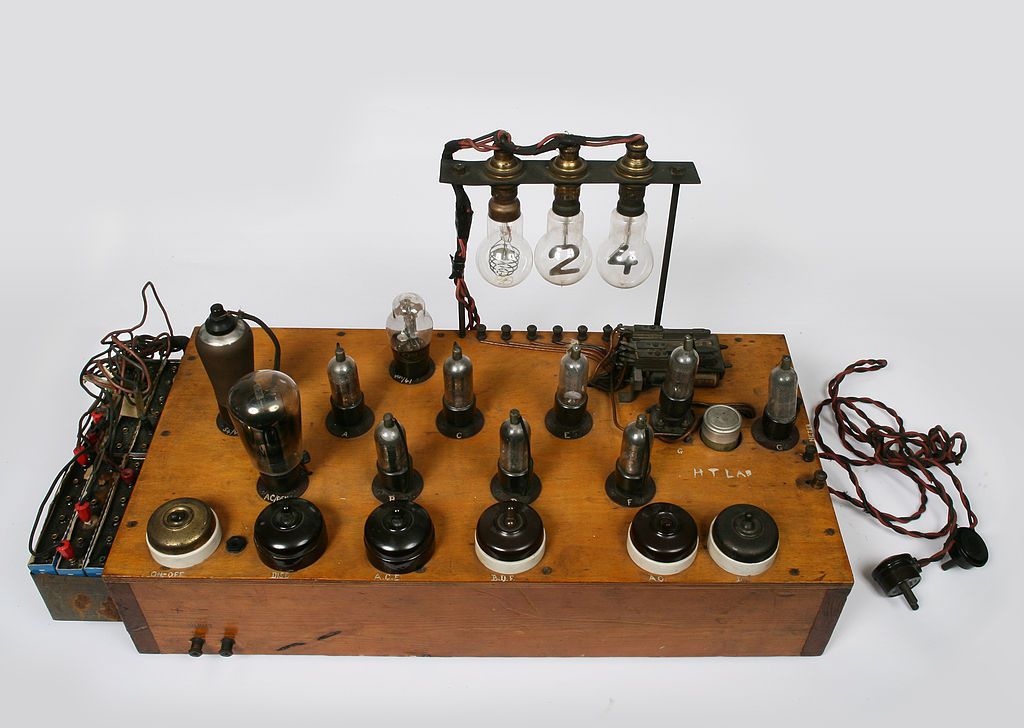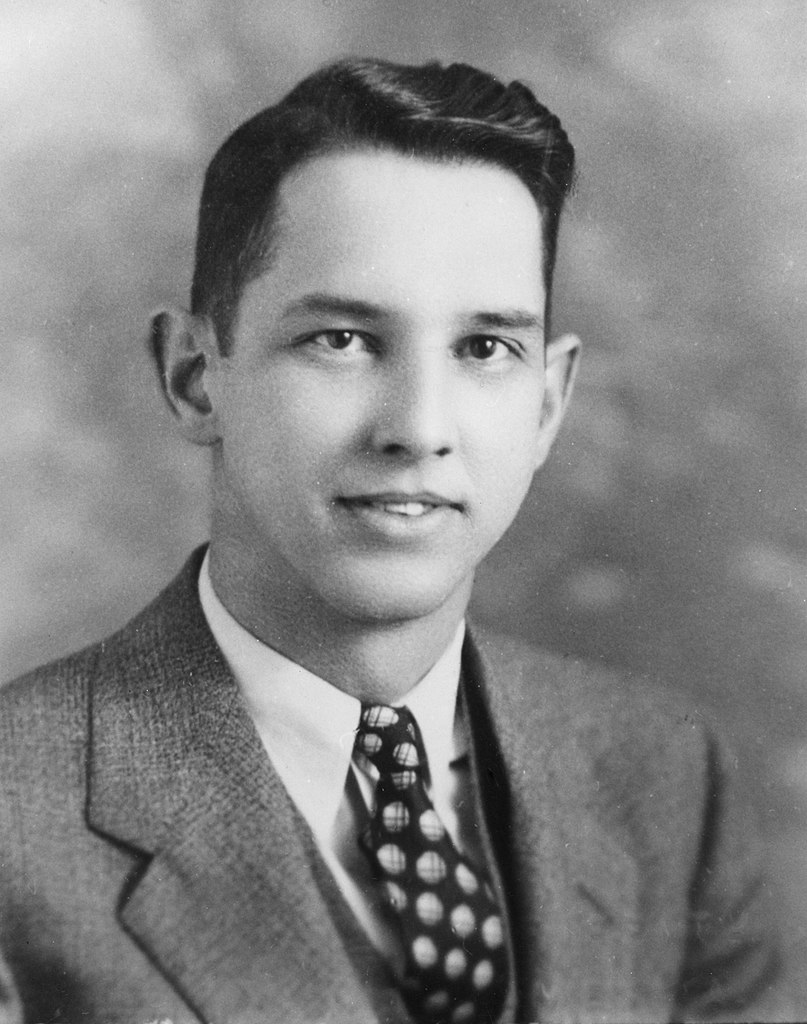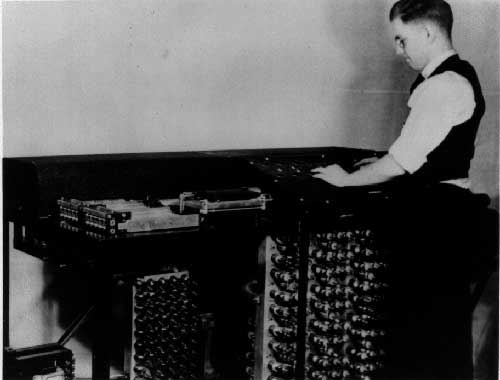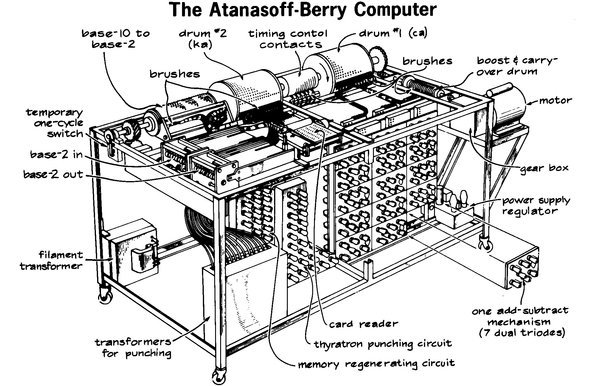Electronic computers, part 1: prologue

As we saw in the last article , radio and telephone engineers, in search of more powerful amplifiers, discovered a new technological area, which they quickly dubbed electronics. An electronic amplifier could easily be turned into a digital switch that operates at a much higher speed than its electromechanical relative, a telephone relay. Due to the absence of mechanical parts, the electron tube could turn on and off in a microsecond or even faster, and not in the ten milliseconds or more required by the relay.
From 1939 to 1945, three computers were created on the basis of these new electronic components. The dates of their construction do not coincide accidentally with the period of the Second World War. This conflict - unparalleled in history by the way it brought people to the yoke of the chariot of war - forever changed the relationship between states and between science and technology, and also brought a large number of new devices into the world.
The stories of the first three electronic computers are intertwined with war. The first was devoted to deciphering German messages, and remained under the cover of secrecy until the 1970s, when he had no interest other than historical. The second, which most readers should have heard about, was ENIAC, a military calculator that was completed too late for him to help in the war. But here we consider the earliest of these three cars, the brainchild of John Vincent Atanasoff .
Atanasov
In 1930, Atanasov, the son of an emigrant from Ottoman Bulgaria , who was born in America, finally achieved his youthful dream and became a theoretical physicist. But, as with most of these aspirations, the reality was not what he had hoped for. In particular, like the majority of engineering and physical students in the first half of the 20th century, Atanasov had to suffer from the painful burden of constant computation. His dissertation at the University of Wisconsin on the polarization of helium required eight weeks of tedious calculations using a mechanical desk calculator.

John Atanasov in his youth
By 1935, having already been a professor at the University of Iowa, Atanasov decided to do something with this burden. He began to figure out possible ways to build a new, more powerful computer. Rejecting analog methods (such as the MIT differential analyzer) for reasons of limitation and inaccuracy, he decided to build a digital machine that worked with numbers as discrete values, not as continuous measurements. From his youth he was familiar with the binary number system and understood that it lays much better on the on / off structure of the digital switch than the usual decimal numbers. Therefore, he decided to make a binary machine. And finally, he decided that in order for it to be the fastest and most flexible, it must be electronic, and use electron tubes for calculations.
Atanasov needed to decide on the task space - for which calculations his computer should have been suitable? As a result, he decided that he would deal with solving systems of linear equations, reducing them to a single variable (using the Gauss method ) —the same calculations that prevailed in his dissertation. It will support up to thirty equations, up to thirty variables in each. Such a computer could solve important tasks for scientists and engineers, and at the same time it would not seem incredibly difficult.
Piece of art
By the mid-1930s, electronic technology had reached an extraordinary diversity compared with the origins that had emerged 25 years before. Two developments were particularly well suited to the Atanasov project: a trigger relay and an electronic counter.
From the 19th century, telegraph and telephone engineers had at their disposal a convenient device called a switch. A switch is a bistable relay that uses permanent magnets to keep it in the state in which you left it — open or closed — until it receives an electrical signal for switching states. But electron tubes were not capable of it. They did not have a mechanical component, and they could be “open” or “closed” as long as electricity flowed or did not flow along the contour. In 1918, two British physicists, William Ackles and Frank Jordan, wired two lamps in such a way that they came up with a “trigger switch” - an electronic relay that always turned on after being switched on from the initial impulse. Ackles and Jordan created their own telecommunications system for the British Admiralty at the end of the First World War. But the Ackles-Jordan circuit, which later became known as the trigger [eng. flip-flop] could also be viewed as a device for storing a binary digit — 1 if the signal is transmitted, and 0 otherwise. In this way, a binary number n of digits could be represented through n triggers.
Ten years after the trigger, there was a second major breakthrough in electronics, faced with the world of computing: electronic counters. Again, as has often happened in the early history of computing, boredom became the mother of invention. Physicists who studied the emission of subatomic particles had to either listen to clicks or spend hours studying photographic recordings, counting the number of detections to measure the rate of emission of particles by various substances. Mechanical or electromechanical counters presented a tempting opportunity to alleviate these actions, but they moved too slowly: they could not register the multitude of events that occurred with a difference of milliseconds.
A key figure in solving this problem was Charles Aryl Winn-Williams , who worked under Ernest Rutherford under the Cavendish Laboratory in Cambridge. Winn-Williams deftly handled electronics, and already used lamps (or valves, as they were called in Britain) to create amplifiers that made it possible to hear what was going on with particles. In the early 1930s, he realized that valves could be used to create a counter, which he called a “binary scale counter” - that is, a binary counter. In fact, it was a set of triggers that could transfer switches up the chain (in practice, he used thyratrons , types of lamps containing not vacuum, but gas, which could remain in the on position after full ionization of the gas).
Winn-Williams counter quickly entered the set of necessary laboratory devices for everyone involved in particle physics. Physicists built very small counters, often containing three signs each (that is, capable of counting up to seven). This was enough to create a buffer for a slow mechanical counter, and to record events occurring faster than a counter with slow moving mechanical parts could register them.

But in theory, such counters could be expanded to numbers of arbitrary size or precision. These were, strictly speaking, the first digital electronic counting machines.
Computer Atanasova-Berry
Atanasov was familiar with this story, which convinced him of the possibility of building an electronic computer. But he did not directly use binary counters or triggers. At first, for the basis of the counting system, he tried to use slightly modified counters - after all, what is addition, if not repeating the counting? But for some reason he could not make the contour contours sufficiently reliable, and he had to develop his own schemes of addition and multiplication. He could not use triggers to temporarily store binary numbers, because he had a limited budget, and had an ambitious goal of storing thirty factors at the same time. As we will soon see, this situation has serious consequences.
By 1939, Atanasov had finished designing his computer. Now he needed a man with the right knowledge to build it. He found such a person in the person of a graduate of the Engineering Department of the Iowa State Institute named Clifford Berry. At the end of the year, Atanasov and Berry built a small prototype. The following year, they completed the full version of the computer at thirty coefficients. In the 1960s, a writer who unearthed their history called it Atanasoff-Berry’s computer (Atanasoff-Berry Computer, ABC), and the name stuck. However, all the shortcomings could not be eliminated. In particular, ABC gave an error of approximately one binary digit per 10,000, which would be fatal for any large calculation.

Clifford Berry and ABC in 1942
However, in Atanasov and his ABC you can find the roots and source of all modern computers. Didn’t he create (with Berry’s skillful help) the first binary electronic digital computer? Is this not the main characteristics of the billions of devices that form and control the economy, society and culture around the world?
But let's go back. Digital and binary adjectives are not the prerogative of ABC. For example, the Bell complex computer (Bell Complex Number Computer, CNC), developed at about the same time, was a digital, binary, electromechanical computer capable of performing calculations on a complex plane. Also, ABC and CNC were similar in that they solved problems in a limited area and could not, in contrast to modern computers, accept an arbitrary sequence of instructions.
It remains "electronic." But, although the mathematical interiors of ABC were electronic, it worked at electromechanical speeds. Since, for financial reasons, Atanasov and Berry could not use electron tubes to store thousands of binary digits, they used electromechanical components. Several hundred triodes that performed basic mathematical calculations were surrounded by rotating drums and buzzing perforating machines, where the intermediate values of all the computational steps were stored.
Atanasov and Berry did a heroic job of reading and writing data on punch cards at tremendous speed, burning them with electricity instead of mechanically making holes in them. But this led to his problems: it was the burning apparatus that was responsible for 1 error per 10,000 numbers. Moreover, even with their greatest efforts, the machine could not “punch” faster than one line per second, so ABC could only do one calculation per second with each of the thirty arithmetic devices. The remaining time the electron tubes sat idle, impatiently “drumming their fingers on the table”, while all this machinery painfully slowly revolved around them. Atanasov and Berry fastened a thoroughbred horse to a cart with hay. (The project manager for the re-creation of ABC in the 1990s estimated the maximum speed of the machine, taking into account all the waste of time, including the work of the operator on the task assignment, in five additions or subtractions per second. This is, of course, faster than a human calculator, but not that speed which we associate with electronic computers.)

ABC scheme. The drums stored temporary input and output on capacitors. The thyratron card piercing scheme and the card reader recorded and read the results of the whole step of the algorithm (eliminating one of the variables from the system of equations).
Work on the ABC stalled in mid-1942, when Atanasov and Berry enrolled in the fast-growing US military machine, which required not only bodies but also brains. Atanasov was called to the Naval Artillery Laboratory in Washington to lead a team developing acoustic mines. Berry married Atanasov’s secretary and found a job in a contract-based company in California so that he would not be called to war. Atanasov for some time tried to patent his creation in Iowa, but to no avail. After the war, he took up other things, and he no longer took up computers seriously. The computer itself was sent to landfill in 1948 to make room in the office for a new graduate of the institute.
Perhaps Atanasov just started working too early. It was based on modest university grants, and could spend only a few thousand dollars on the creation of ABC, therefore, the economy has supplanted all other problems in its project. If he waited until the early 1940s, he could receive a government grant for a full-fledged electronic device. And in such a state — with limited use, with complex controls, unreliable, not very fast — ABC did not become a promising advertisement for the use of electronic computing. The American war machine, despite all the computational hunger, threw ABC to rust in the town of Ames, Iowa.
War Computers
The First World War created and launched a system of massive pumping of investments in science and technology, and prepared it for the Second World War. In just a few years, the practice of waging war on land and at sea turned to the use of poisonous gases, magnetic mines, aerial reconnaissance and bombardment, and so on. Not a single political and military leader could not fail to notice such rapid transformations. They were so fast that enough early wound research could tip the scales in one direction or another.
In the US, there were enough materials and minds (many of which fled from Nazi Germany), and they were apart from the direct battles for survival and domination that affected other countries. This allowed the country to learn this lesson particularly clearly. This was manifested in the fact that extensive industrial and intellectual resources were thrown at the creation of the first atomic weapon. A less well-known, but no less important or smaller investment was the investment in the creation of a radar technology, the center of which was located at the MIT at the Rad Lab.
Similarly, the emerging field of automatic computing received its share of military funding, albeit on a much smaller scale. We have already noted the variety of electromechanical computational projects generated by the war. The potential of computers based on relays was, relatively speaking, known, since telephone exchanges with thousands of relays had already been operating for many years. Electronic components have not yet proven their performance on such a scale. Most experts thought that an electronic computer would inevitably be unreliable (ABC was an example), or its construction would take too much time. Despite the sudden influx of state money, there were few military projects in electronic computing, and they were rare. Only three were launched, and only two of them led to the emergence of efficient machines.
In Germany, telecommunications engineer Helmut Schreier proved to his friend Konrad Zuse the value of an electronic machine in front of the electromechanical V3, which Zuse built for the air industry (he later became known as Z3). Zuse eventually agreed to work on the second project together with Schreier, and the Aviation Research Institute proposed funding a 100-lamp prototype at the end of 1941. But the two men first took up more priority military work, and then their work slowed down the damage caused by the bombings, as a result they could not get their car to work reliably.

Zuse (right) and Schreier (left) are working on an electromechanical computer in the Zuse parents' apartment in Berlin.
And the first electronic computer that performed useful work was created in a secret laboratory in Britain, where a telecommunications engineer proposed a new radical approach to cryptanalysis based on valves. We will reveal this story next time.
What else to read:
• Alice R. Burks and Arthur W. Burks, The First Electronic Computer: The Atansoff Story (1988)
• David Ritchie, The Computer Pioneers (1986)
• Jane Smiley, The Man Who Invented the Computer (2010)
All Articles